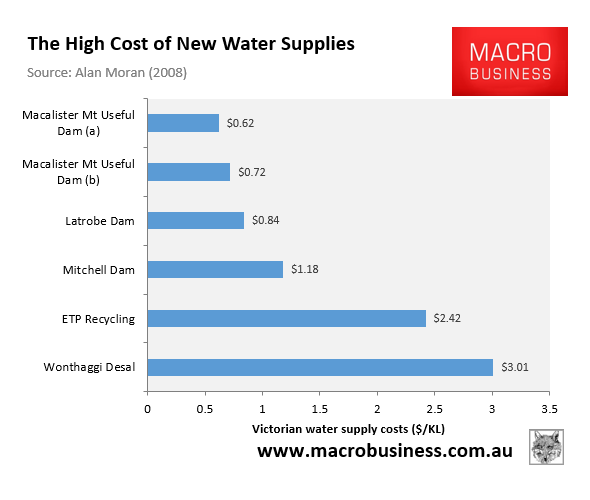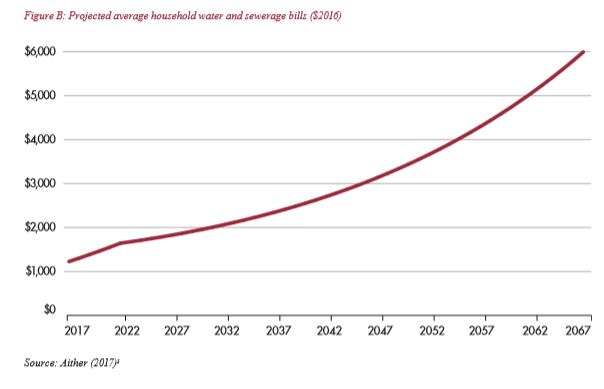The SMH reported in September that “Sydney’s running out of water” and that “the problem will get worse as climate change triggers more intense and frequent extreme weather, and our population booms”.
“The problem is that to fill its dams, Sydney relies heavily on rainwater, which is then used for drinking water. But as these dry up, our water supply dwindles”.
“The Greater Sydney Water strategy, published in 2021, shows by 2060, the city’s water needs will increase by 250 gigalitres of drinking water per year – that’s equivalent to about half the volume of Sydney Harbour”.
Over the weekend, The ABC noted that we are “now in an El Niño period and Australia has just had its driest August to October since 1900”.
In turn, “Sydney Water has already warned city dwellers to brace for water restrictions by this time next year, saying rainfall could potentially hit historic lows over the next 12 months”.
The problem is summarised in the below quote from Ian Wright, an associate professor in environmental science at Western Sydney University:
“We’ve got a bigger population all the time so we’ve got to serve more people potentially with less water to go around”.
He noted that Warragamba Dam supplies around 80% of Sydney’s water, but that was built in 1960 when Sydney’s population was just over 2 million people.
Sydney’s population is now more than 5 million people and is projected to balloon to around 9 million people by 2060.
“The predictions are the climate is going to provide us less rain and the population keeps going up, supply is going down”, professor Wright warned.
“If we look at a long-term sustainable yield we believe that demand is already exceeding that long-term sustainable yield”, Professor Stuart Khan, the head of civil engineering at the University of Sydney, added.
“Melbourne and Adelaide have already turned to desalination plants for nearly half their water use so it is high time we joined their ranks and move forward with boosting our supply options so we’re better placed for future dry periods”, NSW Water Minister Rose Jackson said last month.
Given the anticipated reduction in precipitation due to climate change and the persistent water scarcity that Australia is poised to face in the future, why is the federal government pursuing an aggressive population growth strategy?
Why is the federal government hell bent on running a ‘Big Australia’ immigration policy on the driest continent in the world?
The 2023 Intergenerational Report projects that Australia’s population will reach 40.5 million by 2062-63, driven by long-term annual net overseas migration (NOM) of 235,000:

That means in only forty years, the population of Australia will increase by a combined Sydney, Melbourne, Brisbane, and Adelaide, with Sydney and Melbourne each transforming into megacities of around 9 million people.
Only four years ago, Australia was beset by a severe drought that ran water supplies to perilously low levels.
What will happen the next time there is a severe drought and Australia has to supply water and food to millions more people?
In order to cater to the projected 14 million extra people in forty years, Australia will be required to build a series of expensive, energy-intensive, and environmentally destructive water desalination plants.

As water desalination is considerably more costly than conventional water sources, this will result in increased water prices.
Furthermore, supplying desalinated water to inland areas such as Western Sydney is inherently difficult and costly, because it requires water to be pumped uphill over vast distances.
In turn, residential and business water rates would soar to accommodate the federal government’s mass immigration policy, which will impact lower-income households disproportionately.
Infrastructure Australia projected that real household water bills would more than quadruple due to population growth and climate change, rising from $1,226 in 2017 to $6,000 in 2067:

Water is another example of how the federal government’s ‘Big Australia’ immigration policy severely impacts the environment and the living standards of the working class.
Simply limiting net overseas migration to the pre-2005 average of around 100,000 people a year would enable policymakers to more easily safeguard the nation’s water supply at much lower cost to end users.
The reality is that the ‘Big Australia’ mass immigration policy of the federal government poses the greatest threat to Australia’s water supply.
Cutting immigration to sensible and sustainable levels is, therefore, the number one solution.

